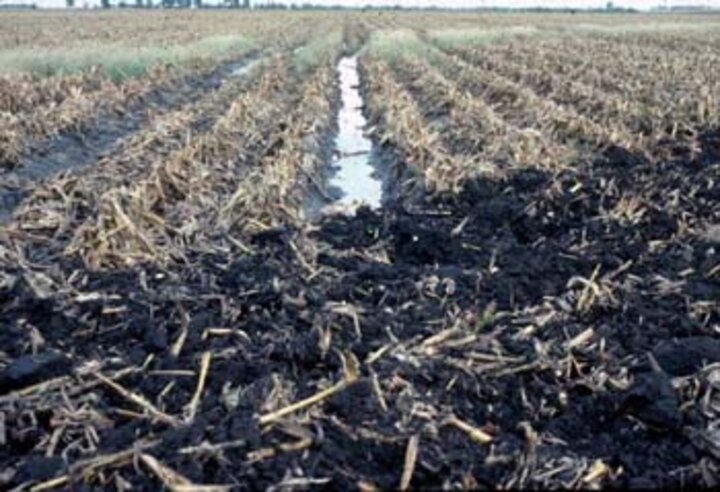
|
| Fields with harvest ruts may need smoothing with shallow tillage; however, producers should wait until the soil dries to avoid forming more compaction. Full width tillage across the entire field is not needed and perhaps a center pivot track filler would be the best implement to use. |
October 26, 2007
With this year's fall rains some fields were harvested when the soil was quite wet and harvest equipment left ruts. Runoff from storms throughout the growing season also created rills and gullies in some fields. After harvest, producers may want to return to their fields to fill in the gullies and resolve compaction problems, but first they need to evaluate soil moisture conditions.
While the weather has dried some and harvest is proceeding, producers should wait until the soil dries more before doing any spot tillage to smooth fields or relieve compaction. The soil may appear dry on the surface, but it's probably still too wet at tillage depth to effectively reduce compaction.
Compaction Action
Driving on or tilling a wet soil creates compaction as the wet soil particles are lubricated and easily slide under the weight of the tires and implements. Compaction is the loss of pore space between the soil particles, and if that pore space is lost, it "reappears" on the soil surface as the rut or as a denser soil at a reduced elevation. Tillage will fluff the soil surface so that the compaction from tillage is not easily seen. Conversely, if large combines and heavy grain carts didn't leave tracks or ruts in the field, the soil was not compacted by them as the soil structure was there to support the weight and tillage is not needed. Usually, the ruts or gullies are as deep as the tillage depth since tillage destroys soil structure and leaves a compaction layer below the tillage depth.
|
Producers should wait as long as possible for the soil to dry before lightly tilling very shallow to smooth the ruts. Better yet, wait until spring for the soil to dry more before using shallow tillage. Producers should resist the temptation to till deeper, thinking that they will get rid of more compaction as the soil will be wetter below the soil surface and more readily compacted. The tillage also will destroy soil structure such that subsequent tillage passes or trips across the field will cause more compaction. The compaction from wheel traffic ruts extends far deeper into the soil than typical tillage operations can reach. Building soil structure is the best way to avoid compaction and wheel traffic rut problems.
Spot Tillage
Usually, ruts or gullies are only in portions of a field, not across the entire field. As such, shallow spot tillage rather than whole field tillage should be used to smooth these areas. Many of the gullies were formed by concentrated flows of runoff. Unless something is done to anchor the soil when the gullies are filled, they will simply wash out again. Seeding a cover crop in these areas will help anchor the soil, especially on sloping soils. Rather than using a wide tillage implement, far less soil will be disturbed by using a center pivot track filler. Many center pivot track fillers also firm the soil into the filled track, helping anchor the soil. Mounting a simple 12-volt spinner seeder in front of the track filler could seed a cover crop at the same time. The roots of the growing cover crop will help reduce compaction and help build soil structure.
Residue Benefits
Producers should leave as much residue standing in the field as possible and minimize full width tillage. Tillage dries the soil, buries residue, destroys soil structure and increases erosion and runoff. Standing residue, still attached, is one of the most effective ways to protect soil from the erosive forces of wind and to capture snowfall. The standing residue will greatly decrease the amount of blowing soil early next spring when wind erosion is at its peak before the planting season.
Producers should consider no-tilling directly into the standing residue to continue the erosion control until crop canopy can take over. Any residue left standing is less residue that has to be cut or handled on subsequent field operations. The worst things a producer can do is to cut the residue loose, allowing it to move and create a mat of residue on the soil surface, or destroy good soil structure with tillage.
Paul Jasa
Extension Engineer
